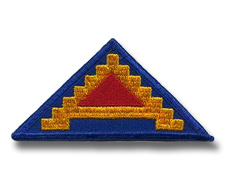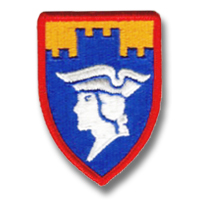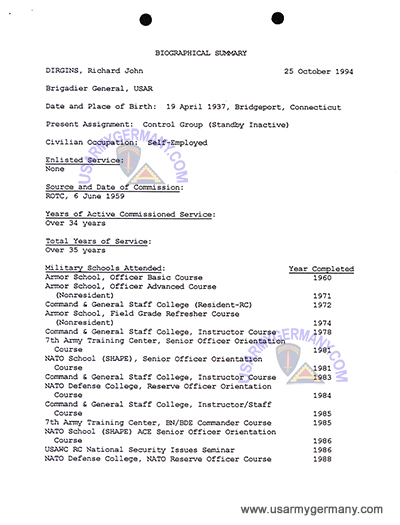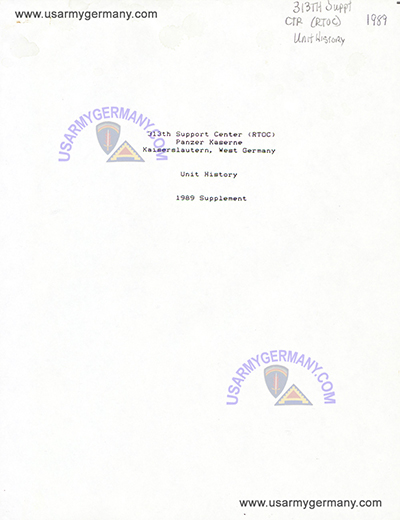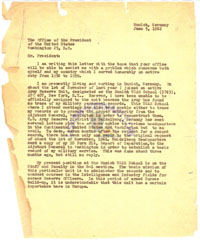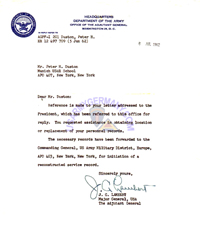| If you do NOT see the Table of Contents frame to the left of this page, then Click here to open 'USArmyGermany' frameset |
||||||||||||||||||||||||||||||
|
7th
Army Reserve Command |
||||||||||||||||||||||||||||||
|
|
||||||||||||||||||||||||||||||
|
||||||||||||||||||||||||||||||
|
|
||||||||||||||||||||||||||||||
| History | ||||||||||||||||||||||||||||||
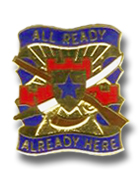 7th Army Reserve Command DI 7th Army Reserve Command DI |
||||||||||||||||||||||||||||||
| (Source: 7th ARCOM website, 1998) | ||||||||||||||||||||||||||||||
|
The 7th Army Reserve Command (ARCOM) traces its history back to 1956, when the first US Army Reserve units -- five US Army Reserve schools 1) -- were established in Europe. For more history on the 7th ARCOM after the end of the Cold War, see the official 7th ARCOM website. |
||||||||||||||||||||||||||||||
| US Army Reserve Affairs, Europe | ||||||||||||||||||||||||||||||
| 1968 | ||||||||||||||||||||||||||||||
(Source: STARS & STRIPES, April 23, 1968) |
||||||||||||||||||||||||||||||
USAREUR Hq kicked off a week-long celebration in Heidelberg on Aprl 22, 1968, commemorating the 60th anniversary of the founding of the US Army Reserves - presently one million men strong. Maj Gen James W. Sutherland, Jr., USAREUR Deputy Chief of Staff (Operations) and Deputy Area Commander for Reserve Affairs, was on hand to commend the officers and staff for their contributions, which he said were "of major consequence to the overall mission of USAREUR". As part of the festivities, Sutherland sliced a large birthday cake which was presented to Col Robert B. Nett, chief of US Army Reserve Affairs, Europe. 1.) He pointed out that the Reserve has been present in and depended upon in two World Wars, Korea, Berlin, and today is distinguishing itself in Vietnam. Army Reserve Affairs, Nett explained, is responsible for the administration, supervision and education of the 400 reserve officers and 1,000 reserve enlisted men not on active duty, but situated in Europe. These reservists are primarily Department of the Army civilians, private businessmen or European residents whose records are kept here. The office, he said, operates two (USAR) schools in Europe - Frankfurt and Munich. Satellite classes are held in Kaiserslautern, Berlin, Heidelberg, Hamburg, Grafenwoehr, Nuernberg, Stuttgart, London, Brussels, Paris, Madrid, Leghorn, Rome and Tripoli. Curricula includes command and general staff courses, and general subjects. At present, USAREUR reserve officers on active duty number 13,110. Nett said his office here takes the records of those reservists - both officers and enlisted men - who select to remain in Europe at the conclusion of their tour of duty. 1.) Col Robert B. Nett has directed the US Army Reserve Affairs Office at Hq USAREUR since June 1967. Prior to Col Nett assuming the position, Col William A. Rau served as Chief, US Army Reserve Affairs, Europe.. |
||||||||||||||||||||||||||||||
| US Army Reserve, Europe | ||||||||||||||||||||||||||||||
1983 |
||||||||||||||||||||||||||||||
| (Source: TRAINING TIMES, March 1983) | ||||||||||||||||||||||||||||||
| Redesignation US Army Reserve Affairs, Europe, a subcommand of 7ATC, has been redesignated as US Army Reserve, Europe. The title change reflects increased duties and responsibilities assigned by Commander, 7ATC. Lt Col (P) C.V. Ford's title has changed from chief (USARAE) to commander (USAR-E). |
||||||||||||||||||||||||||||||
| (Source: TRAINING TIMES, May 1983) | ||||||||||||||||||||||||||||||
| New Reserve Unit The first of the new US Army Reserve, Europe units, the 454th Replacement Detachment, is expected to be activated July 1 (1983). USAR, Europe is a subordinate command of 7ATC and located at McGraw Kaserne, Munich. |
||||||||||||||||||||||||||||||
| (Source: TRAINING TIMES, July 1983) | ||||||||||||||||||||||||||||||
| Reserve News The US Army Reserve, Europe, a subordinate command of 7th ATC, announced recently that Department of the Army has approved establishment of four more USAR units in Europe in FY 83. The units are: These units are staffed by Army Reservists who live in Europe. This brings to five the number of new European USAR units erstablished in FY 83, and a total of nine under the command of USAR-E and 7ATC. (1) United States Army Reserve Military Intelligence Detachment, Heidelberg |
||||||||||||||||||||||||||||||
| (Source: TRAINING TIMES, August 1983) | ||||||||||||||||||||||||||||||
| Reserve Note Col. C.V. Ford, commander, US Army Reserve, Europe, has departed for reassignment as Chief, Mobilization Division, Office of the Chief, Army Reserve. As the first commander of USAR-E, Ford was responsible for the establishment of five new USAR units in Europe, development of the support structure for USAR units, and the establishment of a Joint Uniform Military Pay Systems - Reserve Component input station in Munich. His successor is Col. Carl Sica, presently the senior USAR advisor to the 1st Army, Fort Meade, Md. |
||||||||||||||||||||||||||||||
| (Source: TRAINING TIMES, August 1983) | ||||||||||||||||||||||||||||||
| C & GSC: Key to officers' career, future by Frank Cox MUNICH - Most company grade officers have a common goal; they all want to eventually hold the rank of lieutenant colonel. Who doesn't? A colonel's pay is better, there's more prestige and career opportunities increase. But along with all the "bennies" comes the extra responsibilities: important decisions, leadership factors, tactical scope, logistics, financial management, security, field grade command and principle staff assignments . . . So, to prepare for the big day, an officer needs to become qualified in those things a colonel does. And the best way to get qualified is through the Command and General Staff College. Unfortunately, most officers reading this are stationed in USAREUR, and are unable to attend the resident course at Fort Leavenworth, Kansas. That's where U.S. Army Reserve, Europe and the C&GSC nonresident course come into play. The course, according to the POI, is divided into six phases, each corresponding to an inactive duty training (IDT) or active duty training (ADT) period of instruction. During winter months, the IDT period is instructed -- by USAR officers -- at prearranged areas throughout USAREUR. Persons enrolled in C&GSC are notified of when and where the IDT is to be taught. An IDT period includes instruction on phases one, three and five to provide officers in those phases an equal chance to advance. During summer months the ADT phase is taught. Reserve officers instruct from 64 to 76 hours during each two-week ADT period. Phases two, four and six are taught. But the ADT phase is only taught at one location: Munich. Instruction at Munich is provided by either the 3747th USAR School (based in Frankfurt) or the 3745th USAR School (based in Munich). The 3747th - the largest of all USAR schools - handles personnel assigned to V Corps, SHAPE and 21st Support Command areas. The 3745th instructs personnel assigned to VII Corps and Southern European Task Force (Italy). Although labled a nonresident course, officers must attend the ADT phase full time, usually in a TDY status. According to the POI, completion of one phase is a mandatory prerequisite for attending the next. And each phase is sequence essential. To be eligible to attend C&GSC, reserve officers must be captain or above and have successfully completed a branch officer course prior to 1 Oct. 1983. Also required is a minimum of seven but not more than 18 years commissioned service upon enrollment. Active component requires eight and 18 years respectively. |
||||||||||||||||||||||||||||||
| (Source: TRAINING TIMES, November 1983) | ||||||||||||||||||||||||||||||
USAR celebrates, continues to expand Happy Birthday U.S. Army Reserve, it's your 75th. An organization which is not well understood by many Americans, the USAR is the largest federal Reserve Component of our Armed Forces. Its overall mission is to provide trained men and women capable of performing wartime missions as an integral part of the Total Army. In Europe, the reservists -- and there are many of them -- get needed guidance and directives from a 7ATC subcommand: U.S. Army Reserve, Europe, McGraw Kaserne, Munich. The USAR-E is responsible for command of all Army Reserve units assigned to the U.S. Army Europe, with the exception of one tenant engineer unit. According to an Information Sheet produced by the USAR-E Executive Officer, Maj. James Meade, the Reserve Command in Europe consists of about 300 staff members and 700 students. Meade says Headquarters, USAR-E serves as a command and control operation for subordinate reserve units. USAR-E is also responsible for reserve activities including the annual International Minuteman Competition. Presently, USAR-E heads up nine reserve units in Europe. And, according to Meade, several additional units are expected to be established in 1984. Two related USAR-E units are the 3745th (Munich) and 3747th (Frankfurt) USAR schools. Together, these two schools provide attending students with Command and General Staff College, officer advanced courses and enlisted soldier classes in Primary Leadership and MOS training. The two schools provide educational opportunities to students from within USAREUR, SETAF, AFCENT and SHAPE. Two other USAR-E units with related missions are the 2nd Hospital Center (Forward), Burtonwood Depot, U. K. and the 8th Medical Brigade (Forward), Heidelberg. With the expanding role of the Reserve Component comes a need for experienced personnel to fill empty positions. Soldiers who are considering leaving the service might note that their In Service Recruiter has all the details about Army Reserve opportunities. |
||||||||||||||||||||||||||||||
| 7th US Army Reserve Command | ||||||||||||||||||||||||||||||
1988 |
||||||||||||||||||||||||||||||
(Source: Pillars & Posts, June 3 1988) |
||||||||||||||||||||||||||||||
New training opportunities for reservists The 7th Army Reserve Command, Heidelberg, is seeking Reserve officers and enlisted to fill eight new units being formed in Germany. The Troop Program Units are Rear Area Operational Control (RAOC) groups. Six of the eight RAOCs will come under operational control, and be located in the vicinity, of active duty Army divisions in Bad Kreuznach, Frankfurt, Wuerzburg, Ansbach, Göppingen, and Garlstedt. The remaining two will be under OPCON of a corps and a Theater Army Area Command (TAACOM). A RAOC's mission is to organize and coordinate battle in the rear area. "These soldiers are planners and organizers. They coordinate action in the rear with various combat, service and service support units," explained Col. Robert Dow of the 7th ARCOM. "This is a new concept - to have Reserves involved in this kind of operational planning in a forward theater," Dow added. Each RAOC will have six officer and 10 enlisted paid Reservists in addition to the active component members. Their training schedule will resemble stateside Reserve units -- one weekend a month drill and two weeks a year annual training, with the probability of some exercise play in conjunction with AT. HQ, 7th ARCOM, APO 09102 |
||||||||||||||||||||||||||||||
| RAOC Units formed end of the 1980s/early 1990s | ||||||||||||||||||||||||||||||
|
||||||||||||||||||||||||||||||
1990 |
||||||||||||||||||||||||||||||
(Source: Heidelberg Herald-Post, March 8 1990) |
||||||||||||||||||||||||||||||
Engineer unit moves The 412th Engineer Command, Forward, a reserve unit, has moved from Hammonds Barracks, to the third floor of Building 4260 on Tompkins Barracks, said Maj Dale Bain, Chief of Personnel. |
||||||||||||||||||||||||||||||
(Source: Heidelberg Herald-Post, May 31 1990) |
||||||||||||||||||||||||||||||
7th Army Reserve chief gets star The commander of the Heidelberg-based 7th Army Reserve Command became the first Army Reserve general to head an overseas Army Reserve unit when he was promoted to brigadier general recently. Richard J. Dirgins received his star from USAREUR deputy commander Lt Gen John M. Shalikashvili in a ceremony at Sheridan Kaserne in Garmisch April 28. The 7th Army Reserve Command is responsible for all active Army Reserve units in Europe. Dirgins has commanded the unit since 1987 and was deputy commander in 1986. The 53-year-old Connecticut native has been a member of the Army Reserve program in Europe since 1964. In 1981 he was appointed commandant of the 3745th US Army Reserve School in Munich and in 1984 took over command of the 3747th US Army Reserve School in Frankfurt. Webmaster note: BG Dirgins would command the 7th Army Reserve Command for seven years, from December 1987 until July 1994. During that time, the command would grow from two units to 23 units and from 260 Reserve soldiers to nearly 1,000 reservists. Of his 35 years of active and reserve military service, BG Dirgins served 30 years of that in Germany. Dirgins died of a cerebral hemorrhage in a hospital in Augsburg on January 14, 1995 and was buried in Welden, Germany. In a ceremony held on April 17 2015 at Daenner Kaserne, Kaiserslautern, the headquarters building of the 7th Civil Support Command (successor to the 7th ARCOM) was named for Dirgins. |
||||||||||||||||||||||||||||||
1993 |
||||||||||||||||||||||||||||||
(Source: Heidelberg Herald-Post, March 18 1993) |
||||||||||||||||||||||||||||||
Local employee commands Heidelberg reserve unit A Heidelberg Department of the Army civilian took command of a local Army Reserve unit March 13. Capt. Stephen Karstensen, a command analyst in the Force Management Division at Hq USAREUR, is the new commander of 7th US Army Reserve Comd.'s Hq Company. He replaced Maj. Albert Gardner, who had commanded the company since 1990. In his new position, Karstensen commands approximately 150 reservists. He also assists the ARCOM commander in the planning, coordination and operation of administration and supply matters pertaining to the unit's reservists. |
||||||||||||||||||||||||||||||
(Source: Heidelberg Herald-Post, Dec. 9 1993) |
||||||||||||||||||||||||||||||
7th ARCOM moves to Tompkins Barracks HEIDELBERG (7th U.S. Army Reserve Comd.) -- The headquarters of the 7th U.S. Army Reserve Comd. and the 4th Medical Bde. moved Dec. 6 to Tompkins Barracks, Building 4222, in Schwetzingen from a leased building and warehouse behind Famila Center near Leimen. (Webmaster note: The two units have been located at the Leimen facility since 1986.) Some 47 full-time civilian and military personnel and 222 Reservists are affected by the move. They will occupy space previously used for billeting and storage by two local national services units, the 8951st and 8952nd Civilian Support Group, which have relocated to other facilities. Originally announced for September 1993, the move was delayed two months by minor renovations to the building's interior and the installation of additional electrical circuits. An ARCOM spokesman said, "the facility is inhabitable now, although the working conditions will be a little primitive initially. "Until the contractors finish rewiring, we're probably a couple of months away from having adequate telephone service and a local computer network," he noted. Using existing wires, 5th Signal Comd. has installed, about a dozen telephones scattered aongst the offices in the four-story building. Both units will have new telephone numbers. Both units will share a number for faxes (facsimiles). ARCOM sections are: Headquarters command group; Hq Co.; operations; personnel; and finance. The military mailing address for the two units remains unchanged. It will continue to be Unit 29238, APO AE 09102. Their new civilian address, however, is Tompkins Barracks, Schwetzinger Strasse, Geb. 4222, 68723 Schwetzingen. The 7th ARCOM is the peacetime command and control headquarters for some 23 units and more than 900 soldiers located throughout Germany, Italy, Belgium, the Netherlands and the United Kingdom. These units support the U.S. Army Europe with military intelligence, aviation, transportation, operational, logistical, educational and medical services. Tompkins Barracks honors Pfc. George C. Tbmpkins, a member of the 39th Infanry Regiment, 100th Infantry Div., who received a Silver Star posthumously for his actions on April 3, 1945 near Heilbronn. The barracks were constructed in 1938 by the German Army (Wehrmacht) and named Panzer Kaserne for its new cavalry, tank (Panzer) units. |
||||||||||||||||||||||||||||||
|
|
||||||||||||||||||||||||||||||
| 302nd Support Center (RAOC) | ||||||||||||||||||||||||||||||
(Source: SPEARHEAD, Oct 1988) |
||||||||||||||||||||||||||||||
RAOC stays
ready for war Story by Aria Ala-U-Oini The 3rd Armored Division's Rear Area Operations Center (RAOC) was unique among reserve RAOCs participating in FTX Certain Challenge. "The 302nd RAOC is the first RAOC to be stationed in Europe" said Lt. Col. Glenn E. Cole, unit commander. Stationed in West Germany, the 302nd RAOC is necessary to meet the needs of the modern Army, according to Cole. National Guard units, which are located in the United States, can take as many as 60 days to mobilize. "The RAOC's mission is to seal off the rear area of battle to ensure a safe and steady flow of supplies to the front lines," said Cole. Cole, a civilian banker in West Germany, said the idea of having a reserve RAOC was conceived by Maj. Gen. George A. Joulwan, 3rd Armd Div commander, while he was still at USAREUR headquarters. Joulwan saw a need for a force that would be able to respond to the needs of the Army more quickly. The 302nd RAOC, which is located on Drake Kaserne in Frankfurt, has been in existence since July. Fourteen of the 22 reserve positions are already filled. "All the members in the unit are prior service with different MOS's, " said Cole. SFC Paul E. Bright, unit defense liaison NCO, said another advantage their RAOC has is that it is a reserve unit which works solely with its active duty counterparts. "It's nothing like the reserve units in the states," Bright said. "here, it's a lot more hands-on-training." Bright, an electronic technician in Mainz, said he believes being the first reserve RAOC in Germany is a unique challenge and presents a great opportunity for everyone in the unit to receive intensive training. "It's a new experience for all of us," he said. Even though his unit is a reserve unit, Cole said that they still are an important part of the 3rd Armd Div. "Our people wear the Spearhead patch on their left sleeve and they are proud of it," Cole said, "the only difference between us and the regular Army is we don't train quite as often." |
||||||||||||||||||||||||||||||
| 307th Support Center (RAOC) | ||||||||||||||||||||||||||||||
(Source: Brief Unit History of the 316th Support Center, 7th ARMCOM website - accessed July 26, 1998) |
||||||||||||||||||||||||||||||
The 316th Support Center (Rear Area Operations Center) is the product of the redesignation and inactivation of several US Army Reserve units forward deployed to Europe. The unit was originally organized and activated as the 307th Support Center, a Reserve Divisional Rear Tactical Operations Center (RTOC) located in Garlstedt, Germany. The 307th supported the 2nd Armored Division (Forward). During OPERATION DESERT SHIELD/STORM, the 307th was alerted for mobilization but did not deploy or mobilize. After DESERT SHIELD/STORM, the 307th was restationed to Berlin and redesignated as the 316th Support Center, acquiring the mission of a Corps RAOC. |
||||||||||||||||||||||||||||||
| 313th Support Center (RAOC) | ||||||||||||||||||||||||||||||
(Source: 313th Unit History, 1989 Annual Historical Supplement - AHEC) |
||||||||||||||||||||||||||||||
Only a part of the 67-page AHR is reproduced here - partially for privacy reasons but also to conserve space. |
||||||||||||||||||||||||||||||
| 454th Replacement Regulatory Detachment | ||||||||||||||||||||||||||||||
(Source: Frankfurt Chronicle, Sept 25 1986) |
||||||||||||||||||||||||||||||
Street fightin' men Urban battle plan challenmges reservists by B.J. Rosenberg The mission demanded that the 454th Replacement Regulatory Detachment, from Munich, move into the town, destroy sniper opposition and set up combat operations. It didn't work out that. way. When the smoke had cleared and the "casualties" had been counted, only three of the 17 reservists survived. The rest were "killed" by the enemy, 10 infantrymen assigned to the 21st Replacement Battalion at Rhein-Main Air Base, 454th's operational control unit. Failure of the reservists to assault the main stronghold was the primary reason for their defeat, said 1st Sgt. Henry Morgan, Headquarters and Headquarters Detachment, 21st Replacement Battalion. "The reservists had never had any training of this sort," he said. "So they weren't aware of the traps they walked into. For example, we camouflaged the windows and doors of the buildings with branches, sticks -- anything to obstruct vision and movement. We laid booby traps and grenades. We also had a sniper position on the roof of the building we were guarding. This position probably caused the most damage to the reservists. As they came running out of the treeline, our man just picked them off." The main point behind the exercise was to give the reservists a chance to operate under battlefield conditions, said Morgan. He and his men tried hard to simulate combat. "We know all the tricks," he said. "A lot of my troops are 11 Bravos and this training is the only chance they'll get all year to practice their true job skills. They love it and put their hearts into it. It creates great training for the reserves and it helps us too." Use of the Multiple Integrated Laser Equipment System added a touch of reality to the exercise, said 1st Lt. Debra Trumbull, training officer for the 454th. "MILES hooks up to the rifle," she said. "It sends a laser beam in the direction the ammunition would travel. Each soldier wears sensors on his helmet and web gear. When a direct hit has been scored against him, a beeping confirms the casualty and that soldier is considered `dead.' What's so great about this is the evaluators don't have to go around shouting, `Hey, you're dead.' You can hear it yourself." The 454th is the only Modified Table of Equipment in Europe, said Trumbull. This means the unit does not require additional support. "We can and will pick up and move out on our own," said Trumbull. "We are the only reserve unit here ready to deploy. That's why this training means so much to us. We need to be able to defend and attack on our own. Our combat mission depends on it." During combat, the 454th, with 34 soldiers, will be required to operate in a field environment, processing replacement troops for units close to or on the front lines. "This military operation in urban terrain that we're doing today is only a test," said Trumbull. "Next week, we'll deploy to the field and do the whole mission, from start to finish, including processing some replacement troops." The unit's two weeks annual training with the 21st is not the only experience soldiers get, said Morgan. Every weekend a month is spent sharpening the reservists' soldier skills. "They do very well," he said. "They're a lot better equipped than most reservists, because they actually get a chance to use their skills." Exposing unit soldiers to realistic training means a lot to Capt. Felipe Lopez, 454th commander. "It's doubly important that our training conforms to conditions of the actual mission," said Lopez. "We're not regular Army and we don't get these opportunities very often. When we do, we make the best of them and learn from our mistakes, even though it may be embarrassing at times. Everything is a learning experience. The whole point is that we learn how to do it right -- something the 21st helps us to do." Five adjutant general reserve units trained with the 21st this year, added Morgan. "These soldiers have to learn how to operate in a field situation -- I mean with 24-hour security and perimeter guards," he said. "You don't adjust to these things overnight. There's a tot of fatique and overwork involved. But the best thing is finding out that you can do it and do it well." Training under combat conditions is what Sgt. Carol Dunson, 454th, gained from the exercise. "If we can't cope with this now, how will we be able to adapt on the battlefield," she said. "We'll know exactly what to expect so there won't be any surprises. We get more training being reservists in Germany than I think we would in the States. This makes me feel like I could function in combat. We have a big advantage by being here." SSgt. Evgardo Vega agreed. "It's fun to do this recon stuff. The troops are getting smarter because all the equipment is high tech and they need to be able to operate it. The Army is more of a challenge now, for me, than it ever was. I've been out since 1983 and now I'm doing my reserve time. I figure it's a good way to get my 20. "We're getting better all the time as a unit," he added. "Our people pick up knowledge quickly because they have to and because they're smart. Most of us have desk jobs - mind work. We're not your typical reservists. I guess you could call us the educated killers." |
||||||||||||||||||||||||||||||
| 663rd Movement Control Team | ||||||||||||||||||||||||||||||
(Source: 663rd MCT Unit History, 7th ARMCOM website - accessed July 26, 1998) |
||||||||||||||||||||||||||||||
| The 663rd Movement Control Team was activated on 16 July 1988 under USAREUR Permanent Orders 138-10 and assigned to the 7th Army Reserve Command. Upon activation the 663d MCT was stationed in Vicenza, Italy and began drilling in September 1988. USAREUR Permanent Orders 92-11 attached the 663d MCT to the 14th Transportation Battalion for supervision of operations and training. The 14th Transportation Battalion, also headquartered in Vicenza, was assigned to the 1st Transportation Movement Control Agency located in Kaiserslauten, Germany. The 14th Transportation Battalion provided Transportation Management and Movement Control support to the Southern European Theater, primarily the Southern European Task Force (SETAF) in accordance with USEUCOM DIR 64-1. |
||||||||||||||||||||||||||||||
| 793rd Movement Control Team | ||||||||||||||||||||||||||||||
(Source: 793rd MCT Unit History, 7th ARMCOM website - accessed July 26, 1998) |
||||||||||||||||||||||||||||||
| The 793rd Movement Control Team was activated on 16 July 1988 under USAREUR Permenent Order 138-10 and assigned to the 7th Army Reserve Command. The 793d was originally planned for stationing in Ankara, Turkey. Due to lack of reservists living in Turkey, the unit was moved to Vicenza, Italy and began drilling in February 1990. USAREUR Permanent Orders 92-11 attached the 793d MCT to the 14th Transportation Battalion for supervision of operations and training. The 14th Transportation Battalion, also headquartered in Vicenza, Italy, was assigned to the 1st Transportation Movement Control Agency located in Kaiserslautern, Germany. The 14th Transportation Battalion's area of operation included those portions of Italy that are the responsibility of CINCUSAREUR in accordance with USEUCOM DIR 64-1. |
||||||||||||||||||||||||||||||
| U.S. Army Reserve School System in USAREUR | ||||||||||||||||||||||||||||||
1956 |
||||||||||||||||||||||||||||||
(Source: Annual Historical Report, Headquarters, US Army Europe, 1 July 1956 - 30 June 1957) |
||||||||||||||||||||||||||||||
Reserve Training The changes in reserve training policy and procedures (in USAREUR) were motivated by the realization that the existing system, which was geared to the requirements of assorted groups of reservists of various grades and branches, was not effective. Instead of training each individual to the level required for his use under emergency conditions, the system provided for general training without concentration in any one field, so that the progressive accomplishment of individual officers was difficult to gauge. The adoption of the US Army Reserve School System was considered as the best remedy to inadequate reserve training, and the Department of the Army approved the establishment of the system in Europe effective 1 December 1956. USAR schools were established at Heidelberg, Frankfurt, and Paris with three resident branch departments at each (i.e. 3 of the following branches Infantry, Armored, Engineer, and Adjutant General). Eleven satellite schools were organized such as those at Munich (military intelligence and infantry), Stuttgart (civil affairs and military government) and Nuremberg (infantry) under Heidelberg; Bonn (military intelligence), Kaiserslautern (armored), Wiesbaden (engineer), and Berlin (military intelligence) under Frankfurt; and Orleans (infantry) and London (adjutant general and artillery) under Paris. Certain reserve training outlets that were to be retained included 15-day annual active duty tours with active units or installations and reserve duty without pay in reinforcement training units. The latter involved approximately 175 reservists who were ineligible to attend the new schools or who were unable to do so because of the distances involved. The primary mission of the USAR schools was to instruct and train reserve officers in a progressive system of branch education according to the programs of instruction and detailed lesson outlines provided by stateside service schools. The favorable response to the new program was reflected in improved attendance rates, which rose from about 65 percent to between 85 and 95 percent. |
||||||||||||||||||||||||||||||
| 3745th USAR School | ||||||||||||||||||||||||||||||
| 1961 | ||||||||||||||||||||||||||||||
| (Source: Email from Peter Duston) | ||||||||||||||||||||||||||||||
| In September 1961, my pregnant wife and I headed for Germany for what became one of the adventures of our lives. I had been stationed in Germany between 1957 -1959 in the Regular Army and was transferred to the USAREUR USAR Control Group in July 1959 as I chose an overseas discharge. After six months hitchhiking around Europe I returned home to Massachusetts. During that time as it came out later, my military records went missing. Enrolling in college, I escaped being called up to active duty like all my old Army buddies during the various Cold War crises in the early 60's as established later due to my lost records.
We had planned to settle in Munich so I could attend the University of Munich where I had been accepted. Just prior to our planned departure, the Communists sealed the East German border on 13 August and began building what became known as the Berlin Wall. Our families were horrified that we would still be going to Germany and especially with my wife pregnant. They, like many, thought that WWIII was a possibility and we would definitely be in harm's way, especially worrisome because we were traveling on a shoestring with only one-way tickets and a few hundred bucks in cash - no credit cards in those days. We prevailed and flew out on the last "prop" flight to London because it was the cheapest way to get there. In London, we caught the late summer student train to Germany, again the cheapest way. Thursday evenings at the USAR School, I worked on training schedules, correspondence, setting up classrooms, preparing training aids and running the film projector for training films. I helped plan for the unit Annual Training (AT) to be held at the Intelligence School in Oberammergau. The big stress, however, was still no orders assigning me to the unit. Finally, the CO called me in and said that the IG was coming and I could not continue to train with the School due to lack of orders. Several TWIXes (cables) produced only my original enlistment record. I was very upset at being excluded and especially since we were counting on several months of pay plus two weeks of active duty pay for the AT. |
||||||||||||||||||||||||||||||
 SACom Ration cards issued to Peter |
||||||||||||||||||||||||||||||
| With my wife (the Colonel's daughter) pushing me, I got bold and wrote a letter to the President, our Commander-in-Chief. At that time, it was Kennedy. Little did I know that my letter would get action. My letter from Germany was dated June 5, 1962, the response from Major General Lambert, the Adjutant General was dated July 6, authorizing my assignment . Wow! Although the School was put out by my circumventing the chain-of-command, they were also pleased for me. I got my back pay which was enough for us to buy a cheap used VW. Were we happy! Every free moment, we were on the road exploring with baby Tracy Elizabeth snug in the well behind the back seat. Although we had missed the Oberammergau AT, I received orders assigning me to HQ, SACOM for two weeks and a stroke of luck got us ration and gas cards for a year. It seems that HQ, SACOM didn't know much about reserve activity in Germany and assumed we were PCSing in. We cherished those cards because it gave us access to the PX for diapers, the Commissary for baby food and most of all, cheap gas for our VW. Funny thing, though, as a reservist with the USAR School, I was not authorized any base privileges but as a civilian working for the "Committee" as we called it, we got PX cards - private organization? LOL. | ||||||||||||||||||||||||||||||
Working for the "Committee", I got to hear the latest and hottest news as it came over the "wire". There were confrontations in Berlin that made us nervous. In September 1962, President Kennedy was authorized to call up reservists and 1000's were activated. October 1962, we came very close to war over the Cuban Missile Crisis. I was right there reading the classified wire as it unfolded - scary stuff! In the year that I worked at Radio Liberty, we were plagued by threats to our émigré staff, all representing the national "republics" of the USSR. The Ukrainians were most despised by KGB as they were the most nationalist and, of course, had seriously collaborated with the Germans during WWII. A Ukrainian staffer had been assassinated by a KGB agent coming to work with a cyanide pen. Others had threatening phone calls or were threatened by mail and on the street including threats to their families. We had to brief them on OPSEC and how to keep themselves and their families safe. In February 1963, the Committee offered me a job at the transmitter site on the southern coast of Spain. From there, the powerful transmitters had a clear shot up the Mediterranean into the Soviet Union and at the time, RL's transmitter was considered the most powerful short-wave transmitter in the world. From all reports, life at the transmitter site was idyllic - a Mediterranean beach. We were tempted but I knew I had to finish my degree and it wasn't to happen in Munich. We returned to the States and I was transferred from the Munich USAR School to the Control Group, Ft. Devens, MA. Within a few months, I had found the 1030th USAR School at the Boston Army Base and served there for a number of years while working and studying Slavic Studies at Boston University - my dream was always to get back to Munich. In 1970, I was attached to the 10th Special Forces Group as a reservist teaching them survival Russian and working as Assistant Director of Admissions at Boston University. Taking a leave of absence and with my contacts back in Munich, I pulled off an Annual Training with my old Munich USAR School at the Oberammergau Intelligence School. With my advance travel pay for a first class ticket, I managed to get a family fare for my wife and three children to accompany me. We rented a VW Bug and drove to O'gau where I signed in at the Kaserne. My family was staying with old friends in town - the Seeboeck family had been friends since my active duty days in 1958-60. They were sweet people and gave up their own bedroom for my family. So the summer of 1970 was my last connection with the Munich (3745) USAR School. Subsequently, I served with the Boston (1030) USAR and the Portland (1034) (ME) USAR Schools while a reservist years later. I resigned my MI reserve commission in 1974 in Boston , disillusioned by the military at the end of the Vietnam War and went off to Maine with the back-to-the-land movement. In 1985 while teaching in NH, I was recruited by the Army Reserve into an infantry training company with the 76th Division as an E5 SGT teaching weapons and combat skills in basic training. Later I was an instructor with ROTC cadet summer camp and finally retired at age 60 as a MSG and reserve senior instructor at West Point where I was, among other duties, the "Top" for cadet basic training. |
||||||||||||||||||||||||||||||
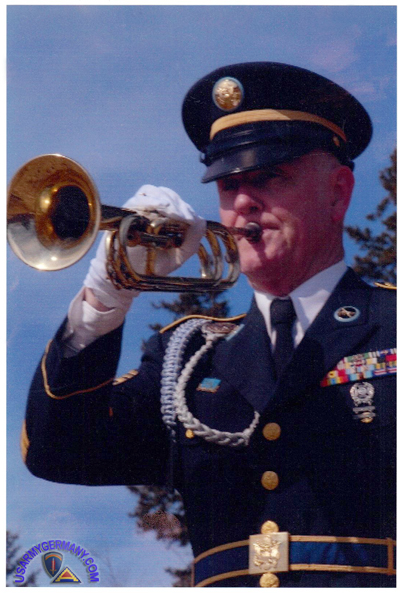 MSG Peter Duston, bugler, Honor Guard, 101st ARW |
||||||||||||||||||||||||||||||
I wear my Blues on a regular basis now at age 73 serving as a bugler with the Air Force's Honor Guard of the 101st Air Refueling Wing, Bangor, ME. Last week, I did three funerals, folding and Taps at one, Taps at another and firing at the third for a retiree service. Because I have both MSG and 1LT uniforms, I wear my light weight NCO uniform in the summer and my old 100% wool LT uniform in the winter for warmth - standing in the snow in a cemetery in Maine is no laughing matter. They all get a big kick out of my persona changes. Moreover, I have a great photo of me wearing a Soviet uniform as Major Pavlov, a military exchange officer presenting "Threat" briefings to basic training soldiers during the late 80's and early 90's at Ft. Campbell and Ft. Benning. It must be the uniform that has kept me in the military! Hehehhehe! |
||||||||||||||||||||||||||||||
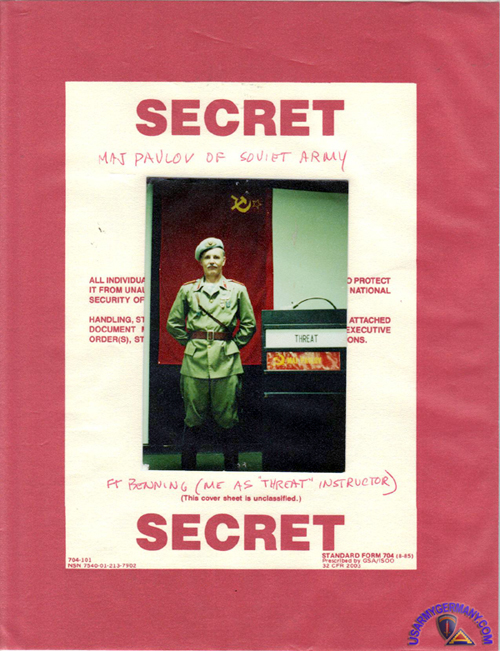 "MAJ Pavlov" of the Soviet Army |
||||||||||||||||||||||||||||||
| In closing, I will be back in Munich to reminisce in late August this year with my wife and two grandchildren to meet their Mom coming in from Kuwait for her mid-deployment leave - the grandchildren live with us while their Mom is gone for a year - she's a combat flight medic with the Army National Guard. McGraw is gone, of course but I'll visit the location and tell them stories of those "hot" days of the Cold War if they choose to pay attention. | ||||||||||||||||||||||||||||||
| 1967 | ||||||||||||||||||||||||||||||
| (Source: STARS & STRIPES, March 14, 1967) | ||||||||||||||||||||||||||||||
| The USAR School in Munich is located on the fifth floor, Bldg 2, McGraw Kaserne. | ||||||||||||||||||||||||||||||
| 3747th USAR School | ||||||||||||||||||||||||||||||
 600.jpg) Location of the 3747th USAR School in the 1970s (GOOGLE) |
||||||||||||||||||||||||||||||
| 1974 | ||||||||||||||||||||||||||||||
| (Source: Email from Donald Halverson) | ||||||||||||||||||||||||||||||
| The 3747th USAR School was located in Frankfurt Germany until at least the end of 1974. The 3745th USAR school was in Munich and I never visited their site. We held a joint summer camp (with both schools) in the Garmisch-Partenkirchen Area. It was a lot of work, but it was a fun event. Another event that we ran each year at the Frankfurt area were the NRA matches. We had an arms room in our basement with 8 match grade 22 rifles and 8 match grade 22 pistols. I would order in 20,000 rounds of 22 ammo for practice time and the matches. We had a Major Brodsky who was instrumental in the operation of the matches. His wife won the matches the last year I was there and they were both very good marksmen for the time I was there. The 3747th USAR and the Active Army Support Unit were located at the Frankfurt CPO offices at 26 Hansa Allee, Frankfurt, which was a civilian building located about 4 or 5 blocks from the IG Farben building and the Officers club directly in back of the IG Farben building. We had classroom and office space on one floor and storage and an arms room in the basement. We also had an 8-car garage out back that we used for storage and sorting of manuals and other classroom material for support of the Command a General Staff college which was taught by the staff of the School. Colonel Arthur T. Curtice was the Commandant of the Frankfurt School (first black commandant of a USAR School, I believe) with approximately 12 to 14 Col’s and LTC’s as instructors at various sites across Europe. Three of our instructors (of Jewish Decent) had survived the Germain internment camps of WWII and had the tattoos to prove it. All of these Instructors held civilian jobs and served as USAR Officers in Europe which you obviously must know. We also had a Major, a Captain and a Chief Warrant Officer along with 12 to 14 Enlisted personnel. This was at the end of the Vietnam War and the Draft was ending and we were having a hard time finding enlisted personnel because it was no longer possible to envoke the possibility of being drafted for failure to perform their duty. We had classes given in SHAPE Belgian; London, England; Bonn; Frankfurt; Berlin; Stuttgart; Kaiserslautern; and Wiesbaden. Basically we could have classes anywhere in northern Europe where we could find students and an instructor. |
||||||||||||||||||||||||||||||
| 1992 | ||||||||||||||||||||||||||||||
(Source: Augsburg Scene, July 1992) |
||||||||||||||||||||||||||||||
3747th USAR Forces School begins training program here Just recently moved from McGraw Barracks in Munich to Augsburg's Reese Kaserne, the 3747th US. Army Reserve Forces School has begun its 1992 Summer session in June. The school, which is part of the 7th Army Reserve Command, provides MOS and career development training for enlisted Reserve soldiers and various career development courses for both Active and Reserve officers. Currently, PLDC, BNCOC and ANCOC (Common core and selected MOS specific), 31C, 54B, 71L, 76Y, 88N, Battle Staff NCO Course, Combat Lifesaver Course and the Instructor Training Workshop are planned for fiscal year 93. Also offered here is the European CGSOC program which parallels that of the resident course at Ft. Leavenworth; it usually takes three years to complete the six phases. Of the over 150 students enrolled in CGSOC in Europe, about two-thirds are active component. Staff and faculty personnel are all reservists. |
||||||||||||||||||||||||||||||
| 3748th USAR School | ||||||||||||||||||||||||||||||
| USAR Military Intelligence Group, Europe | ||||||||||||||||||||||||||||||
| (Source: 7th ARCOM website, 1998) | ||||||||||||||||||||||||||||||
United States Army Reserve
Military Intelligence Group Europe UNIT HISTORY |
||||||||||||||||||||||||||||||
The United States Army Reserve Military Intelligence Group (MIG), Europe boasts a relatively short but distinguished period of service. The "MIG" has been headquartered in Heidelberg, Germany since its formation on August 20, 1983. It was initially designated the United States Army Reserve Military Intelligence Detachment with the headquarters element located in Heidelberg, and separate elements in Munich (Detachment 1), and Berlin (Detachment 2) respectively. The unit's original mission was to support the Special Security Office, both of the United States Army Intelligence Center Europe (USAICE), and the office of the Deputy Chief of Staff, Intelligence, (ODCSI), USAREUR. It provided analysis, collation, production and dissemination of intelligence products as part of the All Source Analysis Center, (G2); and conducted training in intelligence liaison between the USAICE, and elements of the Allied Command Europe. Initial organization of the various elements was the first order of business for the MIG. In October 1983, Detachment 1 held its first drill in the Reserve Center Office, at McGraw Kaserne in Munich, Germany. The "Munich Det" initially involved itself with a temporary mission to analyze the Rear Area Threat to NATO Forces and develop countermeasures based on in-depth studies of historical and contemporary scenarios. Along with this, the detachment continued to participate in numerous exercises with the Heidelberg element. In October 1988, Detachment 1 was absorbed into the headquarters and began drilling in Heidelberg. Upon activation, Detachment 2 held its first drill 120 miles behind the Iron Curtain in the occupied city of Berlin, surrounded by the German Democratic Republic. Because of its limited access with Heidelberg, Detachment 2 was relegated to the operational control of the Office of Deputy Chief of Staff, Intelligence, United States Command Berlin (ODCSI, USCOB). Between January 1984, and January 1989, the "Berlin Det" performed operational intelligence functions for the ODCSI, USCOB. Some of its projects were; counterintelligence support to the Berlin Brigade ARTEP's, Intelligence Information Reports and Intelligence Photographic Reports on Terrorist/Extremist Groups, and an analysis of avenues of approach into West Berlin. In January 1989, the role of the Berlin Det was redefined by USCOB. The element was challenged to plan, research, develop, and conduct an extensive five-day exercise. This exercise simulated an interrogation operation, complete with scenario, role players, secure communications, and a tactical operation center. The final product was viewed as a huge success and the professional reputation of the Detachment assured. However, with the fall of "the wall" and the collapse of Communism in Eastern Europe, the mission of the Berlin Detachment was again reviewed and consequently, realigned within its own headquarters. Noteworthy is the fact that during the past decade, the Berlin Det has supported exercises within the "zone" of Berlin proper; specifically, the Allied Forces Berlin, multinational exercise, DIAMOND TRIAD. As with the detachments, the headquarters in Heidelberg also experienced changes in its mission and functions. Early in its existence, the unit supported the Production Division of ODCSI, USAREUR. The element researched and produced country and area studies; such as, Rail Transportation in Poland and a Counterintelligence Estimate of the Federal Republic of Germany. Then, late in 1987, the MIG was formally tasked with a new mission: to support ODCSINT, USAREUR with Intelligence Support Elements (ISE) to NATO organizations. The ISE concept provided the MIG with new challenges. It required the unit to understand NATO force relationships and structure, contemplate additional threat forces, and train to standard on new communications and automation equipment. Upon mobilization, the ISE's mission would be to deploy with NATO force headquarters providing liaison with Headquarters, USAREUR via secure intelligence COMMS channels. Each ISE consisted of four to six personnel earmarked to support specific NATO operations. The geographic area of interest extended from Norway to Italy, England to Turkey, and all NATO headquarters in between. In March 1989, Exercise CRESTED EAGLE was the first full unit employment of the ISE concept and it proved to be extremely successful. Over the past several years, the MIG has participated in many exercises within USAREUR. Exercises like CRESTED EAGLE, ABLE ARCHER, WINTEX/CIMEX, CATUS JUGGLER, DIAMOND TRIAD, DYNAMIC FUTURE have tested the units ability to be assimilated into the active force structure with little preparation other than drill weekends. The results have been extremely positive; likewise the same conclusion resulted when rendering support to our Allies under the auspices of NATO Exercises. The MIG routinely supported AFNORTH, AFCENT, AFSOUTH, NORTHAG, CENTAG, LANDSOUTH, NAVEUR, under varied conditions in a variety of countries. These included Norway, Belgium, England, France, Italy, as well as Germany. During CATUS JUGGLER '90, the unit was employed as the Opposing Forces in a computer simulation Command Post Exercise located at the Warrior Preparation Center, near Ramstein Air Base, Germany. The MIG portrayed the OPFOR so well, it was administratively "slowed" in order to accomplish the allied objectives of the exercise; a determination made by the senior Headquarters staff. The Berlin Det suffered the same success in DIAMOND TRIAD "89. In DYNAMIC FUTURE '91, the deployed ISE's in Italy were integrated into the participating active components. The request for their continued support in future exercises was proof of their expertise and professionalism. These Exercises will continue to be a crucial test bed for training our soldiers in meeting the requirements of our customers well into the next decade. Christmas-time 1995, brought activation orders for twenty-six members of the unit, who were activated to support the US effort in implementing the Dayton Peace Plan in Bosnia-Herzegovina. Commonly known as "IFOR" (Implementation Force) and more formally as Operation Joint Endeavor. The members of the MIG helped break new ground in the developing doctrine associated with deployment for "peace enforcement" operations. Since that time the unit continues to provide follow-on personnel in support of this historic mission. When Operation Joint Endeavor evolved into Operation Joint Guard, members of the MIG were on hand to carry the torch forward, with many unit personnel still currently deployed in support of these continuing mission iterations. In addition to the more publicized role of supporting operations in Bosnia, the MIG continues in its traditional role of providing up-front intelligence support to EUCOM, USAREUR, NAVEUR, SETAF, NATO, and Allied Command Europe's Rapid Reaction Corps (ARRC). Twenty-three months ago the unit also asserted itself in the strategic environs, by providing continued operational support to Arms Control Programs in direct support of the On-Site Inspection Agency's Treaty Implementation Process. Note: The MIG provides INTEL support to its active duty parent organization USAREUR ODCSINT by performing force protection support, exercise support, and intelligence mission integration during drill weekends. The Group also provides near year round analytical and research functions via the US Army Red Train program, to support the USAREUR Commanding General's Initiatives across the Theater's diversified area of interest. Along similar lines it has been instrumental in the support of USAREUR's International Operations Division, providing desk officers for the Joint Contact Team Program, as well as Partnership for Peace Exchanges. The USAR MIG, a subordinate unit of the 7th ARCOM (headquartered in Schwetzingen, Germany) continues to improve; enabling the unit to efficiently accomplish both its peacetime and wartime mission; all the while maintaining its high commitment to organization personnel. Every year the unit sends its soldiers to military training to improve on their individual development, and intrinsically the unit effectiveness. Personnel from the MIG routinely are the honor and distinguished graduates from professional development and MOS producing courses. A winning mix of military and civilian traits are blended to achieve total integration in meeting the commander's primary intelligence requirements. In short, the full spectrum of talent, dedication, drive and initiative, are manifested in the accomplishments of the Military Intelligence Group, Europe. Throughout its history, the Officers and Soldiers of the MI Group have continued to uphold the fine traditions of duty, honor, performance excellence, and success, that sets them apart from all others. The MIG will continue to accomplish its mission with pride as one of the best units the 7th Army Reserve Command has to offer. The 7th ARCOM's motto of "ALL READY ALREADY HERE" exemplifies the unique capability to rapidly integrate the citizen-soldiers of Europe into the active force and the Military Intelligence Group, Europe will continue to carry that legacy well into the future. |
||||||||||||||||||||||||||||||
|
|
||||||||||||||||||||||||||||||
|
|
||||||||||||||||||||||||||||||
| Related
Links 7th Army Reserve Command - official website |
||||||||||||||||||||||||||||||
